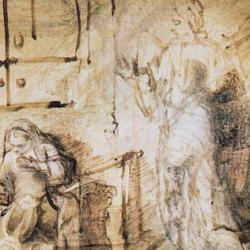There are 12 minor prophets, but these 12 individual books also make up a single book, the “Book of the Twelve.” Like Israel, the minor prophets are both one and many, 12 books and one book. Not only do these prophets form a single book, but the book is neatly arranged, like the other prophetic books of the Old Testament.
The Book of the Twelve begins with Hosea, whom Yahweh instructs to take a wife of harlotry as a portrait of Israel’s harlotry toward her divine Husband. Malachi returns to this theme, stressing the Lord’s unfailing love for His people – Jacob have I loved, Esau have I hated – and charging that Israel has been unfaithful in marriage, – you have dealt treacherously against the wife of your youth, though she is your companion and your wife by covenant. The Book of the Twelve is framed by overt references to Israel’s harlotry, and the Lord’s threat to cut off His people, to divorce His bride. John D. W. Watts notes: “Both Hos 1-3 and Malachi speak strongly of the theme of the love of God for Israel, a theme that is, in so many words, not a part of any other book in the Twelve. Both use the figure of domestic relations to speak about this theme.”
Within the Book of the Twelve, the prophets deal with Israel, Judah, and the nations at different periods of history. Joel and Amos deal with the Northern kingdom, then the Lord turns to the nations for several books, and the final books – Zephaniah through Malachi – deal with Judah from the time of Josiah through the restoration from exile. At the center of this structure are books that deal with the nations – Obadiah is a prophecy against Edom, Habakkuk includes a warning to Chaldea.
Nestled at the center of the Book of the Twelve are two books dealing with Nineveh and Assyria – Jonah and Nahum – and at the center of these, nestled at the very center of the center of the Book of the Twelve, is Micah, which deals with the Assyrian crisis but focuses not on Yahweh’s dealings with the Gentile empire but on His dealings with His own people in the midst of the Assyrian crisis. We can take these three books in sequence: Jonah tells of Nineveh’s conversion, Micah of the destruction and the restoration of Jerusalem, and Nahum the eventual destruction of Nineveh.
And at the center of Micah is the prophecy concerning the restoration of Jerusalem after devastation (Micah 4-5). And at the center of this passage is the announcement of the coming of a ruler from the line of David. At the center of the center of the center of the Book of the Twelve is the promise of a king born in Bethlehem, a town among the clans of Ephrata.
In an article on Jonah in the Fall 2007 issue of JBL, Hyun Chul Paul Kim reflects a bit on the arrangement of the Book of the Twelve. He says, “in the MT, the placement of Micah between Jonah and Nahum, both of which address the fate of Assyria, may highlight another chiastic center [different from the LXX arrangement] . . . which concerns not the fate of Assyria the foreign nation but rather the fate of the ultimate glory of Zion.”
In a footnote, he says, more expansively: “it is possible that the place of Micah [in the MT] precisely alters the focus of the LXX; whereas the LXX in its chiastic order highlights the negative doom of foreign nations, the MT adds another chiastic center, that is, the book of Micah, which is sandwiched between Jonah and Nahum and highlights the positive resurgence of Zion with a righteous Davidic monarch accompanying the destruction of the oppressors.” He cites M. A. Sweeney: “Micah also outlines the process by which a new and righteous Davidic monarch will rise to defeat the nations that punished Israel and Jerusalem, resulting ultimately in a universal peace as both the nations and Israel submit to YHWH’s rule at Zion.”











